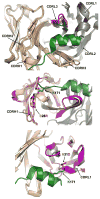Genetic and structural analyses of affinity maturation in the humoral response to HIV-1
- PMID: 28133793
- PMCID: PMC5362126
- DOI: 10.1111/imr.12513
Genetic and structural analyses of affinity maturation in the humoral response to HIV-1
Abstract
Most broadly neutralizing antibodies (BNAbs) elicited in response to HIV-1 infection are extraordinarily mutated. One goal of HIV-1 vaccine development is to induce antibodies that are similar to the most potent and broad BNAbs isolated from infected subjects. The most effective BNAbs have very high mutation frequencies, indicative of the long periods of continual activation necessary to acquire the BNAb phenotype through affinity maturation. Understanding the mutational patterns that define the maturation pathways in BNAb development is critical to vaccine design efforts to recapitulate through vaccination the successful routes to neutralization breadth and potency that have occurred in natural infection. Studying the mutational changes that occur during affinity maturation, however, requires accurate partitioning of sequence data into B-cell clones and identification of the starting point of a B-cell clonal lineage, the initial V(D)J rearrangement. Here, we describe the statistical framework we have used to perform these tasks. Through the recent advancement of these and similar computational methods, many HIV-1 ancestral antibodies have been inferred, synthesized and their structures determined. This has allowed, for the first time, the investigation of the structural mechanisms underlying the affinity maturation process in HIV-1 antibody development. Here, we review what has been learned from this atomic-level structural characterization of affinity maturation in HIV-1 antibodies and the implications for vaccine design.
Keywords: HIV-1; affinity maturation; broadly neutralizing antibodies; computational immunology.
© 2017 John Wiley & Sons A/S. Published by John Wiley & Sons Ltd.
Conflict of interest statement
I declare that I have no conflicts of interest to report.
Figures





References
-
- Janeway C. Immunobiology: the immune system in health and disease. 6. New York: Garland Science; 2005.
-
- Victora GD, Nussenzweig MC. Germinal Centers. Annual Review of Immunology. 2012;30:429–457. - PubMed
Publication types
MeSH terms
Substances
Grants and funding
LinkOut - more resources
Full Text Sources
Other Literature Sources
Medical

